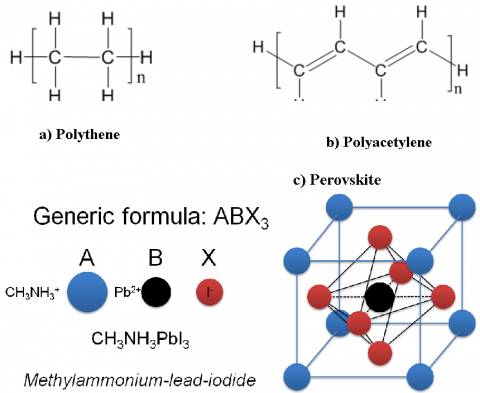Optoelectronics at Physics at Work 2018
Optoelectronics
Changing the World with Flexible Electronics
 Look around you and you will find a diverse range of things, from cling film to artificial limbs, made from plastic-like materials. Flexibility is one of the key aspects of these materials for they are made from long-chain molecules called polymers. But can we add this feature of flexibility to our everyday electronic devices? Well, most of the plastics – which are long-chain molecules made primarily of Hydrogen and Carbon (Fig. 1a) - are insulators and can be used as a shielding on electric cables to protect you from electric shock. However, there is a novel class of plastics that have alternating double and single carbon bonds (Fig. 1b), which allows them to conduct electricity. These materials can be used to produce flexible microprocessors – arrays of field effect transistors (FETs), electronic nano-switches, permitting or blocking the electric current.
Look around you and you will find a diverse range of things, from cling film to artificial limbs, made from plastic-like materials. Flexibility is one of the key aspects of these materials for they are made from long-chain molecules called polymers. But can we add this feature of flexibility to our everyday electronic devices? Well, most of the plastics – which are long-chain molecules made primarily of Hydrogen and Carbon (Fig. 1a) - are insulators and can be used as a shielding on electric cables to protect you from electric shock. However, there is a novel class of plastics that have alternating double and single carbon bonds (Fig. 1b), which allows them to conduct electricity. These materials can be used to produce flexible microprocessors – arrays of field effect transistors (FETs), electronic nano-switches, permitting or blocking the electric current.
And what about flexible-display screens? Or ultra-cheap solar cells? You find them more frequently in movies or press releases than on the market, but meet the hybrid organic-inorganic perovskites – an emerging family of semiconductor light absorbers and emitters that could make these a reality (Fig 1.c). These compounds are so efficient, that a perovskite-based device – whether it is a solar cell, or a light emitting diode (LED) – requires only a very thin film of perovskite material, about a 100th of the width of a human hair. These films can be easily imprinted on a flexible substrate – making them lightweight, bendable and inexpensive. We are actually not so far away from having a smartphone in our back pocket without noticing it (Fig. 2), or having a portable solar cell on your t-shirt (Fig. 3)!

Research in the Optoelectronics Group focuses on exploring these new materials: how they can efficiently convert light energy into electricity (and the other way round), and how these compounds can conduct electricity. We try to optimize their properties to produce efficient devices: light emitting diodes, solar cells and transistors. We also work on designing controllable functional structures using natural polymers – for example using DNA as a glue to hold small particles together for new applications in batteries and displays. We focus on making all our processes compatible with printing techniques or similar so that we could enable large-scale manufacturing, making the end products as inexpensive as possible.
During your visit, we will briefly introduce you to our research areas and perspectives for an electrified, interconnected future. We will also demonstrate to you a handful of state-of-the-art flexible optoelectronic devices (solar cells, displays, electronics), produced by industrial companies which all started around our campus. We hope that our work will inspire you to learn more – and to think about the amazing new applications these new devices could open up.

Further Reading
Dr Sam Stranks about perovskites revolutionizing photovoltaics @ TeD 2016
Basic info on the devices we will present (and many other) and the physics behind them can be found on this science and engineering popularizing website: www.howstuffworks.com
You can also check who produces all the novel devices you will experience during your visit at OE group:
Cambridge Display Technologies: www.cdtltd.co.uk
Plastic Logic: www.plasticlogic.com
Readius: www.readius.com
FlexEnable: www.flexenable.com
Eight19: www.eight19.com
